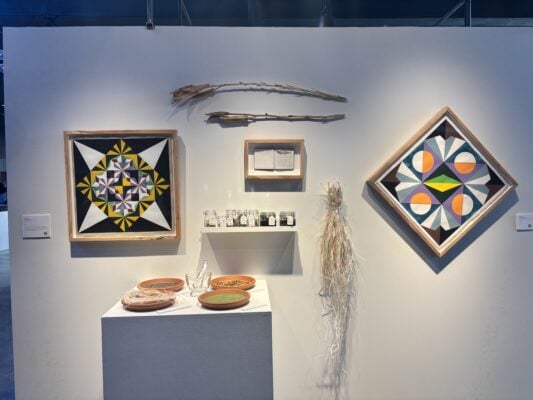
Local visual artist, ethnobotanist and okra grower Shamira Wilson sows the seed of her work — literally.
Born in Louisville, Kentucky, Wilson — known professionally as just “Shamira” — was primarily raised in a multigenerational household in Indianapolis, where she said art “was always present” in her life. Between her great-grandparents and mother, everyone was either tending to gardens, quilting or crocheting. At some point, Shamira said she decided to explore the arts as a career.
“I originally went to school for psychology at Johns Hopkins, and was really interested in doing something that was culturally rooted,” Wilson told the Recorder. “For me, agriculture, for sure, is culturally rooted. It’s a solid foundation in nutrition. Also, for me, art and agriculture are not separate things.”
Wilson’s creative journey began with a deep dive into history, combing through records on agricultural practices and artwork, and the ways they became embedded in things such as quilting, textile work, and painting.
READ MORE: Hoosier-made men’s grooming system gives barbershop-fresh lineups between visits
As an ethnobotanist, Wilson studies the relationship between people and plants and how different cultures use plants for food, medicine, clothing, art and more. Okra is Wilson’s specialty, and she’s been growing it in Indianapolis for the last five years.
Wilson also apprentices with local farmers and runs a research plot at the White River State Park where she is growing approximately 140 plants to study circularity — which is a sustainable economic model designed to eliminate waste by reusing materials as long as possible.

“At the end of the season, I’ll harvest all of the plants and extract the fiber to weave on the loom,” Wilson said. “I’m also harvesting the flowers to save for tea and for pigment, and then also grounding up the dried leaves and extracting pigment from that as well. So, I’m using and honoring all parts of the plant and all of the things that okra can give us, all the gifts it provides, in addition to the nutritional products that we eat as vegetables.”
Wilson’s work has been featured at Newfields, the Children’s Museum, the Indiana State Museum and at BUTTER 2 and BUTTER 5. In just the last three years, Wilson has begun incorporating weaving into her work, including woven braid pieces and a public art installation for the Eskenazi Health Center on 38th Street.
“I’ve put several years into it,” Wilson said. “I’ve learned how to grow okra and become much more experienced as a farmer. So, I know what the materials can do, and going on into the future, I know how we can collaborate, how I can collaborate with the plant to create something even more wonderful.”
The two pieces she exhibited in the 2025 exhibition included “Ornithographies” and “Synaptic Array” — the latter of which is a visualization of what gratitude might look like in one’s brain, Wilson said.
The technique used to visualize the synapses is called synaptic array microscopy, and Wilson said she found and used microscope images of the brain while she was creating “Synaptic Array.”
“For me, it’s when I’m in the garden, when I’m working with plants, it feels like everything else falls away,” Wilson said. “It’s … that space of no thought or zero thought, and that burst of your synapse is just firing and growing, is what I feel when I’m in the garden.”
For more information about Shamira Wilson and her work, visit shamirawilson.com.
Contact Arts & Culture Reporter Chloe McGowan at 317-762-7848. Follow her on X @chloe_mcgowanxx.
Chloe McGowan is the Arts & Culture Reporter for the Indianapolis Recorder Newspaper. Originally from Columbus, OH, Chloe has a bachelor's in journalism from The Ohio State University. She is a former IndyStar Pulliam Fellow, and has previously worked for Indy Maven, The Lantern, and CityScene Media Group. In her free time, Chloe enjoys live theatre, reading, baking and keeping her plants alive.




